Throughout our yearlong celebration of
25 years of Pokémon, we’ve had Pokémon TCG historians provide commentary on some
of their favorite cards from the various region-centric eras of the game. Now,
we’ve reached the point where it all began: the Kanto era.
Of course, since Kanto was the first
region that we explored in the Pokémon Red and Pokémon Blue video games, many of these cards come from
the Base Set, the very first Pokémon TCG expansion from 1999. Nowadays,
everyone knows about Charizard and Pikachu from Base Set; but back in the
early days, beyond those super-famous Pokémon was a whole new universe of
exciting cards waiting to be collected and led into battle. Read
on to see what cards from that and other early expansions stood out to our
Pokémon TCG superstars.
We’d also like to give a special thanks to these awesome experts who have shared their knowledge with us all year long!
Tord Reklev
Three-Time International Champion
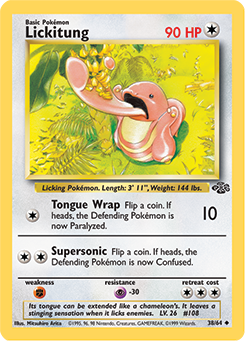
During competitive play back in 1999,
Lickitung (Jungle, 38/64) never really got the credit it deserved. One
of the main reasons was its weakness to Fighting types. This seemed like a huge
issue at the time because the format was so centered around Hitmonchan (Base
Set, 7/102).
Still, having 90 HP was massive back
then and made for a solid tank. It’s important to remember that the early
formats had incredibly powerful Trainer cards, but comparably fragile Pokémon. Energy
Removal (Base Set, 79/102) could strip away Energy effortlessly turn
after turn, while Gust of Wind (Base Set, 93/102) left no Pokémon safe.
Scoop Up (Base Set, 78/102) could save your attacker from getting Knocked
Out as well. All these strong Trainer cards made games incredibly grindy, with
victory often going to the player who successfully preserved their resources
best. It was not uncommon for games in this format to last upwards of 50 turns,
making decking out far more likely than winning on Prizes. Lickitung needed only
1 Energy to attack for damage and could make the opponent Paralyzed to buy even
more time. This made it extremely cost efficient and potentially the uncrowned champion
of the Base Set–Jungle
format.
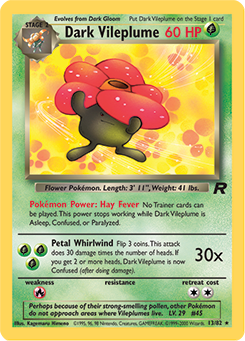
Not long afterward in the year 2000,
the Team Rocket expansion was released. Trainer cards just kept getting
better. At this point they were powerful enough to strip away an opponent’s
entire hand as early as the first turn of the game. Like Lickitung, Dark
Vileplume (Team Rocket, 13/82) is another Pokémon that did not receive
the credit it deserved. Its Pokémon Power, Hay Fever, was by far the most
impactful in the format, blocking any Trainer cards from being played at all.
Since the game was still in its early stages, there was no differentiating between
Trainer cards, meaning only Pokémon and Energy cards were left to be played.
This could slow down the game tremendously and allowed Pokémon with a higher Energy
cost to be used.
One of my favorite combinations of
cards is Dark Vileplume, Alakazam (Base Set, 1/102), and Snorlax (Jungle,
11/64). Dark Vileplume protects Snorlax from losing its Energy and Alakazam
can move the damage counters away from Snorlax. When fully set up, this field was
near unbeatable. Dark Vileplume only had one realistic counter; Muk (Fossil,
13/62) with its Toxic Gas Pokémon Power.
Jason Klaczynski
Three-Time Pokémon TCG World Champion
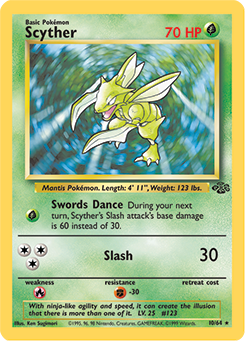
With 70 HP and free retreat, Scyther (Jungle, 10/64) was an
impressive Basic Pokémon by 1999’s standards. Able to attack using Colorless
Energy, it fitted into nearly every deck following its debut in the game’s
first expansion set. Its Resistance to Fighting-type Pokémon made it an
effective counter to Hitmonchan (Base Set, 7/102), a Pokémon that had
dominated the earliest days of the game.
Your deck didn’t need to play Grass Energy to make use of Scyther,
but if it did, you gained the added bonus of Swords Dance. Thanks to Double
Colorless Energy (Base Set, 96/102), a first turn Swords Dance
immediately threatened a 60-damage Slash on the following turn. With PlusPower (Base
Set, 84/102), this Slash could reach 70 damage, enough for a one-hit Knock
Out of popular Pokémon such as Hitmonchan, Electabuzz (Base Set, 20/102),
or even an opposing Scyther. Though your hand didn’t always contain the cards
needed to pull this off, even the threat of it could be enough to disrupt your
opponent’s plans.
Scyther remained a competitively viable card throughout its years
in the game. When Cleffa (Neo Genesis, 20/111) and other 30 HP
Baby Pokémon began flooding into decks in 2000 and 2001, Scyther’s Slash attack
offered an effective way to land one-hit Knock Outs against them.
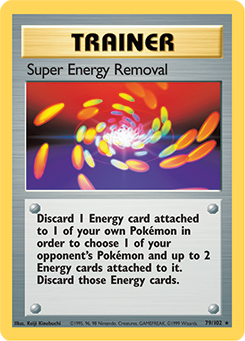
Though the first generation of expansions released hundreds of
Basic and Evolution Pokémon, only a small percentage of them made their way
into successful decks. One reason for this was that before any Pokémon could be
added into a deck, players first had to answer an important question: Could
this Pokémon endure Super Energy Removal (Base Set, 79/102)? If the
Pokémon needed more than two Energy to attack, the answer to that question was
almost always no.
Super Energy Removal was an incredibly oppressive force in the
game, turning dozens of exciting Pokémon with powerful attacks into little more
than novelties (the renowned Charizard (Base Set, 4/102) was no
exception!). The unfortunate reality was that a constant stream of Energy
Removal (Base Set, 92/102) and Super Energy Removal wouldn’t permit
these Pokémon to deliver their strongest attacks.
Many of those who played with Super Energy Removal have wondered
if the game might have been better off without it ever existing. However, its hidden
beauty was that it forced players to preserve their precious Energy cards
carefully. This process created a skill-intensive game that placed a huge
emphasis on resource management. It’s for this reason the game’s earliest
formats, like 1999’s Base Set–Fossil, remain my favorite to play to this
day.
Ross Cawthon
17 World Championships Appearances, Two-Time Worlds Runner-Up
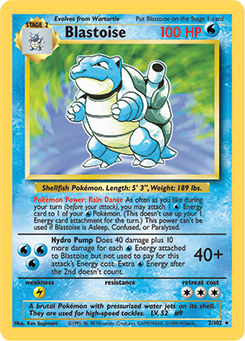
While Charizard may have been the most popular card out of the
three first partner Pokémon from Pokémon Red and Pokémon Blue,
Blastoise (Base Set, 2/102) was definitely the most successful in Pokémon
TCG tournaments. Its Rain Dance was the best Pokémon Power of those in Base
Set. While many Evolution Pokémon struggled to power up big attacks due to
Energy Removal (Base Set, 92/102) and Super Energy Removal (Base Set,
79/102), Blastoise could power up any Water-type Pokémon instantly, making
it the best Evolution deck of the earliest Pokémon era.
Another thing I love about this Blastoise is that the
legacy it began has endured for more than two decades. Blastoise-EX
and Blastoise both
had nearly identical Abilities to the original Rain Dance Pokémon Power and
were popular decks. For a significant period of the last two decades, players
could build decks around this Ability. One of the fun aspects of the Pokémon
TCG is when we get to associate certain gameplay mechanics with specific Pokémon,
giving them a bit of character beyond (in this case) just being “Water type.”
Some other legacy examples from the Kanto region include Dark Vileplume (Team Rocket, 13/82) stopping
Trainers, Electrode (Base Set,
21/102) knocking themselves out to provide Energy, and Muk (Fossil,
13/62) (and later Garbodor)
stopping Pokémon Powers and Abilities.
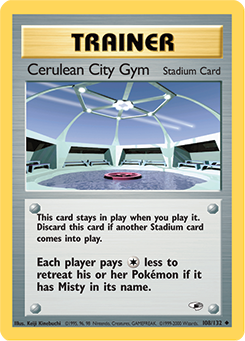
The Gym Heroes and Gym Challenge expansions are two
of my favorites. Gym Leaders’ Pokémon in these sets, and the Dark Pokémon of
the Team Rocket expansion, were the first of many themed Pokémon that we
would see in the TCG. The Gym Leaders’ Pokémon felt particularly special to me
as a kid who had first played the video games, as now I could play as the Gym Leaders
that I battled in the game and pretend I was one of them. Brock and Misty’s
Pokémon were particularly cool to me since those characters were so prominent
in the Pokémon animation.
I chose Cerulean City Gym (Gym Heroes, 108/132) as my pick
from these sets as Water-type Pokémon were always my favorite. I could have picked
Misty’s Starmie (Gym Heroes, 56/132) or the Misty (Gym Heroes,
18/132) card itself, but I thought it was extra cool to see the Stadium
cards, each with elements of the gyms you battled in the video game (or saw on
the show). Stadiums were also a new type of card introduced in these expansions—one
that still plays a big role in the game. Stadiums were the first subclass of
Trainers, later joined by Supporter cards and Pokémon Tools over the first few
years of the game.
Michael Pramawat
Europe International Champion, Worlds Runner-Up
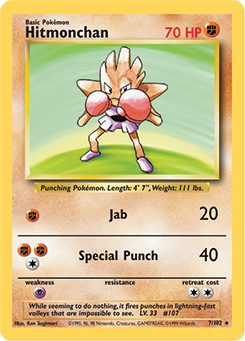
Hitmonchan (Base Set, 7,102) is
one of the most iconic cards ever printed. Its Jab attack does 20 damage for 1 Fighting
Energy, and its Special Punch attack hits for 40 for 2 Fighting and 1 Colorless
Energy. This card has a lack of depth and complexity, but was released when the
game was brand-new. Back in this era, people were just starting to figure out how
to play the Pokémon TCG and simply tried their best to take six Prize Cards.
Times were much simpler, although in hindsight, there were a lot of control
decks that could have been built. Basic Pokémon had around 30-50 HP, so unleashing
Jab in combination with PlusPower (Base Set, 84/102) could set you up
for victory nicely.
Hitmonchan was the main Pokémon in a
deck called Haymaker. The main strategy of this deck was simply to Knock Out as
many small Pokémon on your opponent’s Bench as possible. More recent players
would know this approach’s name as Big Basics, but when the game was new, this
strategy was devastating. One of the first decks I ever built was Haymaker, and
it basically introduced me to playing the game. If you ever get a chance to try
this old deck out, I hope you will enjoy it just as much as I did.
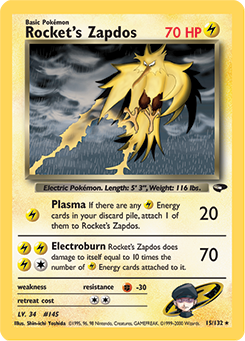
This card holds a special place in my
heart. Zapdos is my favorite Pokémon, and I always enjoy a good wrestling heel.
So, when I went to my first ever major event, I knew I had to play this card. In
retrospect, Rocket’s Zapdos (Gym Challenge, 15/132) is a really bad
card, but to my childhood self, it was the best card ever printed. This card
can use its Plasma attack to accelerate Energy and then deliver a hefty 70
damage with Electroburn while doing 30-40 damage to itself. There are ways to
make this card viable with others such as Defender (Base Set, 80/102),
but that was way too advanced for me; so I just attacked.
Another thing I enjoy about this card
is the art. Zapdos shooting out bolts of lightning is so cool! I also like the
idea of Zapdos, a Legendary Pokémon, being commanded by a Team Rocket Grunt. The
reasons I like this card may be very basic, but we all have things we like for
nonsensical reasons. Rocket’s Zapdos was one of my favorite cards as a child,
and it remains a favorite to this day.
Mike Martin
20-year Pokémon TCG Professor
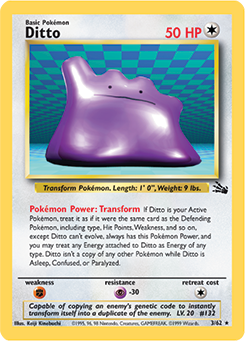
When you look at the original version
of the Pokémon TCG’s Rulings Compendium, you will find that rulings on Ditto’s (Fossil,
3/62) Transform Pokémon Power take up a whopping six pages. Professors
actually had to separate them into 11 different categories to make it more
manageable for players and Judges. Because of this, people would often come up
to me and say, “You must hate Ditto!” But to the contrary, Fossil Ditto
is absolutely my favorite Pokémon card of all time!
Transform was a Pokémon Power that had
an incredibly broad scope in how it interacted with just about every aspect of
the game. Essentially, it turned Ditto into whatever Pokémon it faced off
against in the opponent’s Active Spot. It also allowed you to turn any Energy
attached to it into whatever Energy type you wanted. This made for some very
complicated interactions as games were played and Ditto changed from one
Pokémon to another. But if you understood the principles of how the Pokémon
Power worked, then you could figure out what should happen.
That’s why I loved Ditto. Playing with
it, or judging games in which it was involved, were like solving a puzzle—something
I love to do. While we have seen other effects in the game that possess some
limited aspects of Transform, we’ve never again had a card that had all of
this Ditto’s power. A truly unique card.
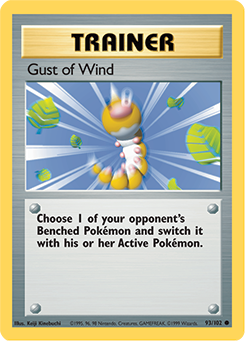
Gust of Wind (Base Set, 93/102)
is one of the original six power cards from Base Set. You either played
these cards in your deck, or you didn’t win tournaments. “Gust of Win”—as it
was often nicknamed—allowed you to choose one of your opponent’s Benched
Pokémon and pull it into their Active Spot. This could be a weak Basic Pokémon
that they were hoping to evolve into a useful Evolution Pokémon, or it could be
one of their attackers that had taken a lot of damage and was now trying to
hide on the Bench to avoid a Knock Out. Once Active, you would Knock it Out for
a guaranteed Prize.
Because it was so powerful, a lot of
people never expected to see a card like it ever printed again. Weaker versions
appeared for a while, then, over 10 years later, Pokémon Catcher was printed, and it had the exact same
effect! Well, for a couple of years anyway… Two years later, erratum was issued
and now all existing and future prints of Catcher require a coin flip to work. Currently,
if you want to bring up an opponent’s Benched Pokémon without flipping a coin,
you must use your one Supporter for the turn to do it. And that’s a much more
balanced cost for such a powerful effect.
The Pokémon TCG community would not be the same without these five contributors to the game, and we appreciate their valuable insights.
About the Contributors

Tord Reklev
Tord Reklev is a contributing writer for Pokemon.com. He is a longtime player from Norway, playing the game since he was 6 years old. He is notable for being the only Masters Division player to win the North America, Europe, and Oceania Internationals, and he recently made Top 4 at the World Championships. Outside of the game, he is a student and enjoys playing tennis. You can find him at most big events, and can follow him on Twitter at @TordReklev.

Jason Klaczynski
Jason Klaczynski is a three-time Masters Division World Champion (2006, 2008, 2013) and the 2015 US National Champion. Jason began playing the Pokémon TCG during the initial Pokémon craze of 1999 and played competitively from that point through 2017. Since then, Jason has focused on re-exploring and writing about the game’s earliest formats, which he regularly plays with friends.

Ross Cawthon
Ross Cawthon is a longtime player, starting to play tournaments in 2000. He is the only player to compete in all 17 Pokémon TCG World Championships, finishing as a finalist in 2005 and 2011, and a semi-finalist in 2016. He is known for creating many new “rogue” decks over the years. Ross has a Ph.D. in astrophysics and studies dark energy (not to be confused with Darkness Energy cards).

Michael Pramawat
Michael Pramawat is a seven-time Regional Champion and International Champion. He has competed at the highest level and was almost World Champion, finishing second in 2010. Michael is a master of the Pokémon TCG and continues to play with the goal of being the very best, like no one ever was. You can follow him on twitter at @michaelpramawat.

Michael Martin
Michael Martin, AKA “PokePop,” hasn’t won a single tournament. He has been judging and running Pokémon TCG events since 2000 and has been invited to judge at every single Pokémon World Championships. He also helps maintain the Pokémon TCG Compendium, where all official game rulings for Organized Play are collected. ‘Pop misses seeing all the players and other Professors in person and can’t wait for live events to resume.
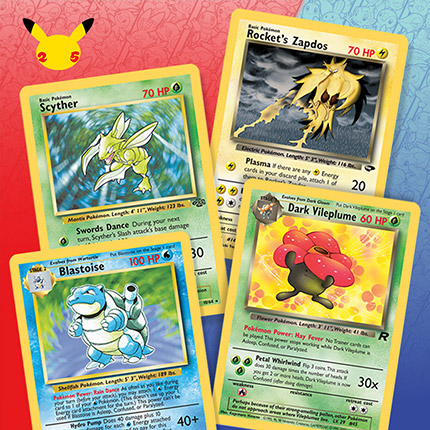
Source: Pokemon

